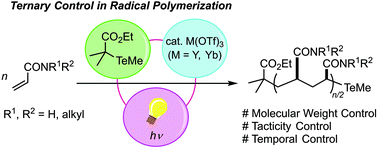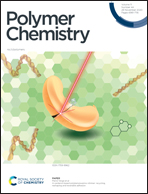Tacticity, molecular weight, and temporal control by lanthanide triflate-catalyzed stereoselective radical polymerization of acrylamides with an organotellurium chain transfer agent†
Abstract
Dual control over molecular weight and tacticity in the polymerization of N,N-dimethylacyrlamide, N,N-diethylacrylamide, N-isopropylacrylamide, and acrylamide was achieved by organotellurium-mediated radical polymerization (TERP) in the presence of Y(OTf)3 or Yb(OTf)3 as a Lewis acid catalyst. While previous dual-control reactions have been limited to the synthesis of low-molecular-weight polyacrylamides, the current conditions significantly expanded this limitation. The high compatibility of the TERP chain transfer agent and dormant species to the Lewis acid was demonstrated by nearly complete end-group fidelity. Stereoblock copolymers consisting of atactic and isotactic PDEAA blocks were also successfully synthesized. Temporal control while maintaining dual control was also achieved by using photoactivation of organotellurium species. The effect of tacticity on the polymer structure in the gas phase was estimated for the first time by ion mobility spectrometry, revealing that the collision cross section increased as the meso diad selectivity of the polyacrylamide increased.

- This article is part of the themed collection: Polymer Chemistry Most Popular 2020


 Please wait while we load your content...
Please wait while we load your content...